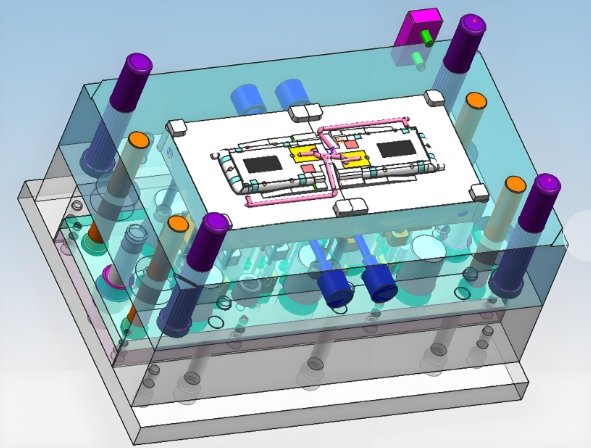
Aerospace electronics need extreme precision. Every component must withstand heat, pressure, and vibration. Electronic injection molding ensures high-performance parts. Mold makers create lightweight, durable components for aircraft systems. From sensors to control panels, injection molding shapes aerospace technology.
1. Why Aerospace Electronics Need Injection Molding
1.1 High Precision for Critical Components
Aircraft systems require exact measurements. Injection molding ensures uniformity.
1.2 Lightweight Materials for Fuel Efficiency
Aerospace parts must be light but strong. Molded plastics reduce weight.
1.3 Heat and Chemical Resistance
Aircraft electronics endure extreme temperatures. Molded parts resist heat and chemicals.
1.4 Vibration and Shock Absorption
Injection-molded materials absorb shocks. This protects sensitive electronics.
1.5 Cost-Effective Mass Production
Injection molding produces high volumes quickly. This reduces manufacturing costs.
2. Aerospace Electronics That Use Injection Molding
2.1 Flight Control Systems
- Control panels and buttons.
- Sensor housings for stability control.
2.2 Communication Systems
- Antenna casings.
- Insulated connectors.
2.3 Power Distribution Units
- Circuit board enclosures.
- High-voltage insulators.
2.4 Avionics and Navigation Equipment
- Radar and GPS housings.
- Wire harness connectors.
2.5 In-Flight Entertainment Systems
- Lightweight casings for screens.
- Noise-resistant speaker components.
3. Key Materials for Aerospace Electronic Injection Molding
3.1 Polyetheretherketone (PEEK)
- High heat resistance.
- Excellent mechanical strength.
3.2 Polyphenylene Sulfide (PPS)
- Withstands extreme temperatures.
- Chemical and flame-resistant.
3.3 Liquid Crystal Polymer (LCP)
- Perfect for miniaturized electronics.
- Superior electrical insulation.
3.4 Polyimide (PI)
- Extremely heat-resistant.
- Used in high-temperature circuits.
3.5 Acrylonitrile Butadiene Styrene (ABS)
- Impact-resistant.
- Used in lightweight enclosures.
4. The Injection Molding Process for Aerospace Electronics
4.1 Step 1: Designing the Mold
Mold makers create detailed molds for each component.
4.2 Step 2: Material Selection
Engineers choose heat-resistant plastics.
4.3 Step 3: Injection Molding Process
Molten plastic is injected into precision molds.
4.4 Step 4: Cooling and Solidification
Parts cool quickly for a stable structure.
4.5 Step 5: Quality Testing
Every component undergoes strict testing.
4.6 Step 6: Assembly and Integration
Molded parts are assembled into aerospace systems.
5. Challenges in Aerospace Electronic Injection Molding
5.1 Meeting Aerospace Industry Standards
Parts must pass FAA and ESA regulations.
5.2 Extreme Durability Requirements
Components must last under high stress.
5.3 Lightweight but Strong Materials
Balancing strength and weight is crucial.
5.4 Resistance to High Altitude Conditions
Materials must function in low-pressure environments.
5.5 Electrical Conductivity and Insulation
Proper insulation prevents electronic failures.
6. Innovations in Aerospace Electronic Injection Molding
6.1 Overmolding for Enhanced Durability
Combining materials strengthens aerospace parts.
6.2 Multi-Shot Molding for Complex Components
Allows different materials in a single part.
6.3 Smart Polymers for Adaptive Electronics
Self-healing plastics enhance durability.
6.4 3D Printing for Rapid Prototyping
Speeds up new product development.
6.5 AI-Driven Quality Control
Artificial intelligence ensures precision in production.
7. The Future of Injection Molding in Aerospace Electronics
7.1 More Advanced Lightweight Materials
Future polymers will be even stronger and lighter.
7.2 AI and Automation for Faster Production
AI-driven molding increases efficiency.
7.3 Higher Precision in Micro-Molding
Tiny components will be even more accurate.
7.4 Sustainable and Eco-Friendly Aerospace Plastics
Recyclable materials will reduce waste.
7.5 Improved Heat and Radiation Resistance
New materials will withstand extreme conditions.
Electronic injection molding plays a vital role in aerospace electronics. Mold makers ensure precision, strength, and lightweight components. As technology advances, injection molding will continue to shape the future of aerospace engineering.
